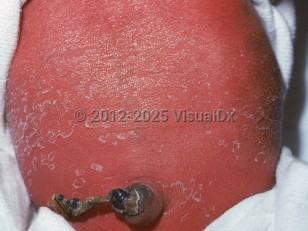Postmaturity desquamation
Alerts and Notices
Important News & Links
Synopsis

Postmaturity neonatal desquamation may occur in postmaturity syndrome, which is caused by placental insufficiency and is estimated to account for 2.2% of obstetricians' deliveries. Postmaturity syndrome can occur prior to, on, or after the expected date of confinement. Since the underlying etiology of this syndrome is an insufficient placenta, a majority of the cases occur post term as the fetus outgrows the functional abilities of the placenta. Postmaturity syndrome is of concern; as placental function decreases, it delivers fewer nutrients and oxygen to the fetus. One study found that gestation of 43 weeks or more resulted in about twice the perinatal mortality compared with birth at 37-42 weeks.
Vernix is a white cheesy substance that consists of sebaceous glands and desquamated cells from the amnion. This substance forms a thick coating around the neonate in utero by 36-38 weeks. The purpose of vernix is to protect and hydrate neonatal skin, and some studies have demonstrated antibacterial qualities to this substance. In postmaturity syndrome, the newborn is almost devoid of vernix. The loss of this leads to skin that is dry and scaling with superficial cracking and desquamation of the palms and soles.
In addition to the dermatologic manifestations, a newborn with postmaturity syndrome will exhibit other findings suggestive of placental insufficiency such as weight loss and the passage of meconium prior to birth. These have additional consequences. Postmature infants may develop hypoglycemia after birth, while aspiration of meconium can be life-threatening.
Postmaturity neonatal desquamation typically resolves in the first few weeks with no treatment required.
Vernix is a white cheesy substance that consists of sebaceous glands and desquamated cells from the amnion. This substance forms a thick coating around the neonate in utero by 36-38 weeks. The purpose of vernix is to protect and hydrate neonatal skin, and some studies have demonstrated antibacterial qualities to this substance. In postmaturity syndrome, the newborn is almost devoid of vernix. The loss of this leads to skin that is dry and scaling with superficial cracking and desquamation of the palms and soles.
In addition to the dermatologic manifestations, a newborn with postmaturity syndrome will exhibit other findings suggestive of placental insufficiency such as weight loss and the passage of meconium prior to birth. These have additional consequences. Postmature infants may develop hypoglycemia after birth, while aspiration of meconium can be life-threatening.
Postmaturity neonatal desquamation typically resolves in the first few weeks with no treatment required.
Codes
ICD10CM:
P08.22 – Prolonged gestation of newborn
SNOMEDCT:
1263607001 – Postmaturity syndrome
P08.22 – Prolonged gestation of newborn
SNOMEDCT:
1263607001 – Postmaturity syndrome
Look For
Subscription Required
Diagnostic Pearls
Subscription Required
Differential Diagnosis & Pitfalls

To perform a comparison, select diagnoses from the classic differential
Subscription Required
Best Tests
Subscription Required
Management Pearls
Subscription Required
Therapy
Subscription Required
References
Subscription Required
Last Updated:02/05/2018

